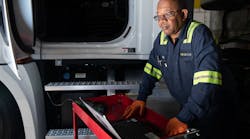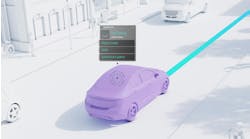Fleets expect reliability from their equipment. The timing is ripe for buying new equipment. New equipment promises to reduce the cost of operation and improve the profit picture. Additionally, new equipment is getting smarter, and that intelligence is even becoming available to smaller fleets.
This is the beginning of the era of clear and timely warnings on the status of equipment. Fleets are notified of a defect, damage, or deterioration with enough time to fix the problem using normal systems, techniques, and locations. This is done with the new tools of today’s sensor measured, connected, and analyzed world.
We will get deeper into the nature of breakdowns and provide insight on the vendors using self-reporting methods and cloud-based diagnostics, condition monitoring, and artificial intelligence (AI) systems.
Detectable versus random failures
Vehicle breakdowns are caused by specific failure modes that can be categorized as detectable or random.
Many tire failures can be categorized as detectable. For example, a technician or driver can visually inspect tires, or use tools such as tread depth gauges, tire pressure gauges, or thumpers. An inspection may determine that the tire tread is wearing out or the tire has a slow leak. The failure mode is detectable well in advance of a problem.
Alternately a random failure mode, like a road hazard caused by driving over debris, is difficult or impossible to detect in advance.
Similarly, a gradual increase in engine temperature is detectable in advance, but a catastrophic failure of a component like the water pump or thermostat is not.
The most common failure type is random. In fact, as far back as the 1970s the U.S. Navy studied their equipment failures and found that more than three quarters of failures were categorized as random.
A random failure is one that is not proceeded by notable deterioration. It could be due to a component with a hidden defect that finally surfaces or a mis-operation of the equipment. Fleets can help lower random failure modes through processes such as driver training on defensive, or comprehensive pre- and post-trip checklists. But once in operation, fleets currently cannot anticipate these failures.
Telematics functionality of today
Paccar’s full-service leasing group, PacLease, provides Kenworth and Peterbilt trucks to fleets across the U.S. Each of the company’s 3,500 units communicates critical conditions to dispatch in real time. The fleet maintenance manager can either communicate with the customer’s dispatcher or, in some cases, the Paccar team can directly message the driver.
“We could possibly head off a service call by contacting someone,” says Rick Tapp, maintenance manager, PacLease. “Possibly some lights or an accessory was left on, or maybe the unit was broken into and the door was open.”
A Class 8 truck might be monitoring 50 to 100 sensors in various parts of the power unit alone (not to mention additional sensors monitoring trailer information).
Since tires are one of the biggest operating costs, they are closely monitored. Take an overinflated tire for example (See Fig. 1). Overpressure can only come from incorrect filling of the tire with air. Simply reducing some pressure will directly increase tire life and save money. The intervention stops a failure cascade in its tracks. A side benefit is that this level of knowledge dissuades drivers from many types of behavior’s that encourage random failures in the first place.
This type of communication is the simplest and most basic application of telematics.
Proactively address vehicle issues
The next example goes a step further by addressing a potentially catastrophic situation. In this case, the driver receives active communication and suggestions on how to handle the issue from the system.
The system tells the driver to stop immediately before additional damage is done to the vehicle. It also generates automatic interventions, so the driver knows what is happening.
The engine itself detects a problem and executes a protective routine to derate the power to extend life (See Fig. 2). The driver then has the ability to get to a location where the problem can be dealt with correctly.
Finally, the system tells the driver to make certain checks that might solve the problem completely. But if not, it locates the nearest authorized service center (See Fig. 3).
The system also informs the driver that it will take some time for the “check engine” light to turn off, while the system verifies the condition is resolved (See Fig. 4).
There are several parts of this solution that should to be highlighted.
The most interesting aspect is that the system uses artificial intelligence (AI) to put useful information in the hands of the driver when it is needed most.
The system also empowers the driver with simple instructions or suggestions to resolve the problem.
Other aspects of the system communicate the issue to the maintenance team, who then are able to use the system to find the root cause of the problem.
Another example
On the fleet operations side, telematics is used for a wide variety of tasks. Many of the tasks have nothing to do with maintenance but are critical for a more seamless business process. Lee Long, director of fleet services at Southeastern Freight Lines, says he has basic telematics on every asset. The privately-owned less-than-truckload (LTL) fleet utilizes their telematics system to handle and streamline invoicing, bills of lading, and delivery signatures.
An important byproduct is lower maintenance costs by catching issues while they are still small, and improved reliability because faulty equipment is not sent out on the road. Being a large LTL fleet, reliable service is what keeps customers happy and coming back.
Every morning their fleet expert reviews the fault codes so that an intervention can be made before there is a serious maintenance issue, or even an accident. Long estimates a 10 to 15 percent reduction of incidents attributable to that review.
For example, a specific issue occurred when there were some clutch activation faults with Eaton transmissions. The telematics system picked up the codes and initiated actions to fix the problem permanently. In an issue with their Cummins engines they identified candidates for possible high pressure that were forcing silicates from the intake that got into the oil and polished the bore.
Currently, they do all analysis on an ad hoc basis and do not use AI to flag issues. But Long noted that all the data is in their PeopleNet system so it should be a smooth transition when the company decides to move forward.
Prediction in action
Taking a proactive approach, logistics company Transervice has worked with numerous customers to assess and analyze the performance of vehicle systems. Decisions can then be made before a failure occurs to service the vehicle or replace the component.
Transervice partners with fleets to provide dedicated contracted maintenance and full-service leasing, among other available services.
Transervice utilizes Trimble’s TMT fleet maintenance management software to track inventory, cost, component lifecycle, and more. In particular, Transervice’s Vice President of Maintenance, Matt Copot, says a dedicated team will provide insight on the performance and optimal lifecycle for components based on a variety of criteria to determine and assess failure points.
“We could be researching an average lifecycle of an alternator, starter, or battery, and this helps us determine what that cost is and what that repair time is,” Copot says. He provides an average failure at a 350,000-mile interval, as an example. “We might scale it back ahead of that (failure point) in order to replace it before it breaks down… and figure out where specifically we want to replace that component on a proactive basis.” Copot confirms the team will determine the median breakdown mileage, as well as the high and low mileage outliers.
Transervice works with all truck OEs on a regular basis. Copot says that the lifecycle of components can vary significantly by truck manufacturer. “We do break it out by vehicle manufacturer, so if we are changing a DEF [diesel exhaust fluid] doser valve for the Freightliner it is going to be a different interval than it would be for a Peterbilt,” says Copot.
Established PMs
During regular PMs, Copot says technicians will conduct ECM downloads for each power unit to review the engine data, validate parameters, and review updates provided by the OEM. To gather this information, Transervice uses the Noregon JPRO diagnostic scan tool.
Reviewing the engine data allows the maintenance team to determine if there are any active or inactive engine trouble codes. “Whether they’re active or inactive, we research them, and we clear them, and complete repairs accordingly,” explains Copot.
Reviewing this ECM data also allows technicians to validate the fleet’s set parameters – such as idle times, road speed, and cruise control – to confirm the vehicle is operating within specified guidelines.
Transervice will optimize PMs by prioritizing OEM notifications, to determine if the suggested update or service should be handled immediately, or at the next scheduled service.
“One of the challenges with predictive maintenance is knowing to predict the severity and how do you actually weigh the consequences verses continuing down the road with it,” confirms Copot.
Confirm what costs the most
“Repair and maintenance costs, we've found over the last five years, are up 21 percent,” Copot says. “When you look at the data you try to sort it down to those components that are driving the cost, the most. Whether it be idle times or aftertreatment systems, or overspeeds, you start to break your data down into those types of silos.”
Reviewing the highest cost silos can help implement better maintenance practices, address concerns such as staff training, and analyze current operating procedures.
“If we see a driver having multiple hard brake applications, we can go back to the driver and ask, ‘What’s causing you to have all these hard brake applications? Is it a factor of the conditions that you’re driving in? Is it construction? Or is it just the type of driving behavior that we want to change?’” says Copot.
Ultimately the feedback from this data is beneficial for two reasons: it can drive both the fleet to make better purchasing decisions on future asset specifications, and it can help the industry to make a better product.
Copot says the Transervice team will work on an individual basis for each fleet it serves, to ensure the recommended service, and even future truck specifications, are in the best interest of their customers.
“Your feedback, especially as you’re getting all this data back from your telematics, [is] feeding all this information to people and sharing [it, which] certainly helps [the] overall improvement of the vehicles,” he says.
As far as challenges, the first step is buy-in throughout the company. Once the decision is made to move forward, integration of software and consolidation of data can be a challenge, says Copot. “Getting the [software systems] to talk to each other and pull out some sort of dashboard — these are the 10 items that we want to pull out from all 1,000 trucks, and here’s the format that we want to put in so it’s easy to read — we can always get into the weeds a little further and find out what those numbers are showing us.”
While predictive maintenance is still in its early stages, it will continue to drive optimization with vehicle utilization and help to improve vehicle uptime.
Copot says that technicians who receive active notifications from an asset in the service bay are becoming more familiar with the proactive maintenance process.
The first step is plugging in every vehicle that comes to the shop with a scan tool, and then reviewing the codes and engine data to become accustomed to the process.
“It doesn’t necessarily have to be the person who’s looking at the computer, but the technicians are getting used to it too. Those people that are on the shop floors, men and women turning the wrenches, they’re getting prompted with these messages and getting more familiarity with [understanding] what’s broken on that piece of equipment that came in, or scheduling [the equipment] in and already knowing what that repair flow is going to look like.”





